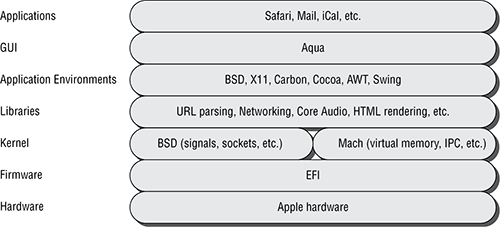Chapter 1
Mac OS X Architecture
This chapter begins by addressing many of the basics of a Mac OS X system. This includes the general architecture and the tools necessary to deal with the architecture. It then addresses some of the security improvements that come with version 10.5 “Leopard”, the most recent version of Mac OS X. Many of these security topics will be discussed in great detail throughout this book.
Basics
Before we dive into the tools, techniques, and security of Mac OS X, we need to start by discussing how it is put together. To understand the details of Leopard, you need first to understand how it is built, from the ground up. As depicted in Figure 1-1, Mac OS X is built as a series of layers, including the XNU kernel and the Darwin operating system at the bottom, and the Aqua interface and graphical applications on the top. The important components will be discussed in the following sections.
Figure 1-1: Basic architecture of a Mac OS X system

XNU
The heart of Mac OS X is the XNU kernel. XNU is basically composed of a Mach core (covered in the next section) with supplementary features provided by Berkeley Software Distribution (BSD). Additionally, XNU is responsible for providing an environment for kernel drivers called the I/O Kit. We’ll talk about each of these in more detail in upcoming sections. XNU is a Darwin package, so all of the source code is freely ...

